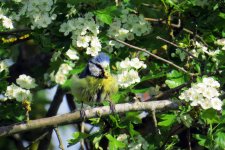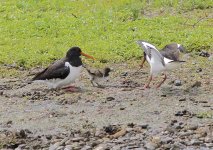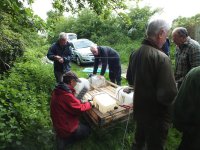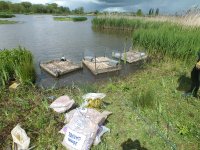Phil Andrews
It's only Rock and Roller but I like it

Lapwing breeding history at Upton Warren
Unfortunately no breeding information exists prior to the production of the first annual report 1984, reflecting how common the species was a breeding bird in the county. The 1980s saw a small breeding population of around three pairs most year but it was habitat improvements in the early 1990s that saw an increase in both the size of the breeding population and its rate of success in fledging young. The remodelling of the Broadmeadow, Amy’s Marsh and the South West Marsh at the Moors Pool all brought about positive results for the next decade or so, with improved success reaching a peak in the mid 1990s – 1995 saw 11 breeding females produce 18 chicks of which 9 went on to fledge, 1996 had 15 breeding females fledging 13 young and 1997 saw 17 breeding females fledging 11 young. Numbers then started to decline again before a small blip around 2004 and 2005, possibly caused by the increased security offered by the Avocets breeding at the Flashes and the installation of the fox-proof fencing around the Flashes. However the last three years have failed to produce any firm evidence of breeding resulting in any fledged young – 2007 saw at least ten young hatched but none survived any longer than three weeks. However the presence of juvenile birds in the late summer flocks in recent years suggests that Lapwing do continue to breed successfully somewhere within the vicinity of the reserve.
Between 1984 and 2007 there were 142 breeding females, a small number of which double-brooded, fledging a total of 99 young (with males often being polygamous it is more correct to count breeding females rather than breeding pairs). For the period 1984 to 2007 an analysis of breeding show a rate of under one (0.68) fledged bird per breeding attempt, a marginally better rate of success than Little Ringed Plover (0.58 fledged birds per breeding attempt). Studies have shown that the dominant pairs tend to nest the earliest (sitting birds have been seen as early as the last week of March), selecting the best feeding areas, with later nesters showing a much greater mortality rate with their chicks also taking longer to fledge. As with most breeding waders, Lapwings face a variety of obstacles, many of which inter-act with each other. Many clutches are lost to the attentions of Coot and Carrion Crow whilst the trampling of their nests by the likes of Canada Geese remains a constant issue. Predation, often by foxes but also mink, is one of the main causes of mortality amongst chicks. A lack of food in certain years has resulted in birds and their young moving off the reserve into neighbouring fields, making them far more vulnerable to attack. As with Little Ringed Plover, Lapwing are susceptible to the flooding that can occur on both sides of the reserve in May and June which can not only wash away nests but also carry off the young from early breeders. Finally, spreading phragmites not only provides additional cover to predators but also limits the amount of suitable feeding habitat and nesting opportunities and the previous removal of livestock from the reserve has a detrimental impact from this perspective.
Unfortunately no breeding information exists prior to the production of the first annual report 1984, reflecting how common the species was a breeding bird in the county. The 1980s saw a small breeding population of around three pairs most year but it was habitat improvements in the early 1990s that saw an increase in both the size of the breeding population and its rate of success in fledging young. The remodelling of the Broadmeadow, Amy’s Marsh and the South West Marsh at the Moors Pool all brought about positive results for the next decade or so, with improved success reaching a peak in the mid 1990s – 1995 saw 11 breeding females produce 18 chicks of which 9 went on to fledge, 1996 had 15 breeding females fledging 13 young and 1997 saw 17 breeding females fledging 11 young. Numbers then started to decline again before a small blip around 2004 and 2005, possibly caused by the increased security offered by the Avocets breeding at the Flashes and the installation of the fox-proof fencing around the Flashes. However the last three years have failed to produce any firm evidence of breeding resulting in any fledged young – 2007 saw at least ten young hatched but none survived any longer than three weeks. However the presence of juvenile birds in the late summer flocks in recent years suggests that Lapwing do continue to breed successfully somewhere within the vicinity of the reserve.
Between 1984 and 2007 there were 142 breeding females, a small number of which double-brooded, fledging a total of 99 young (with males often being polygamous it is more correct to count breeding females rather than breeding pairs). For the period 1984 to 2007 an analysis of breeding show a rate of under one (0.68) fledged bird per breeding attempt, a marginally better rate of success than Little Ringed Plover (0.58 fledged birds per breeding attempt). Studies have shown that the dominant pairs tend to nest the earliest (sitting birds have been seen as early as the last week of March), selecting the best feeding areas, with later nesters showing a much greater mortality rate with their chicks also taking longer to fledge. As with most breeding waders, Lapwings face a variety of obstacles, many of which inter-act with each other. Many clutches are lost to the attentions of Coot and Carrion Crow whilst the trampling of their nests by the likes of Canada Geese remains a constant issue. Predation, often by foxes but also mink, is one of the main causes of mortality amongst chicks. A lack of food in certain years has resulted in birds and their young moving off the reserve into neighbouring fields, making them far more vulnerable to attack. As with Little Ringed Plover, Lapwing are susceptible to the flooding that can occur on both sides of the reserve in May and June which can not only wash away nests but also carry off the young from early breeders. Finally, spreading phragmites not only provides additional cover to predators but also limits the amount of suitable feeding habitat and nesting opportunities and the previous removal of livestock from the reserve has a detrimental impact from this perspective.










